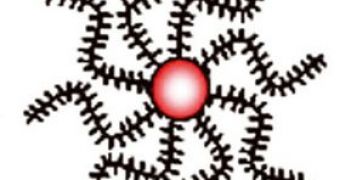Gold is one of the elements which don't react to most of the other known chemical substances, that's why it is a noble metal; but when it comes to polymers it will be quite 'willing' to let itself coated with the material. Scientists created nanoparticles, out of a combination of gold and polymers that can mimic some of the biological functions.
Scientists at the Max Plank Institute of Colloids and Interfaces, have been successful in creating a gold nanoparticle 2 to 14 nanometers across, coated with a combination of polymers which, in the presence of a water and oil solution, crosses the boundary of the system in a targeted manner. This experiment could serve as a model to create channel targeted medically active ingredients, which could pass through the biological membranes of our bodies, that have been impassable in the future.
The methylacrylate polymer developed by the Fraunhofer Institute for Applied Polymer Research in Potsdam, attach themselves to the gold nanoparticle to create branches of polyethylene glycol, similar to the dishwashing brushes, which can be controlled by the scientists to serve their purpose.
The water solubility of the nanoparticle, is given by the polymers branch formations, which use the hydrogen atoms to create bonds with the water molecules. By adding a salt, and heating up the solution, the bond between the hydrogen atoms in the polymer and the water is weakend, turning it into a fat solvable nanoparticle that can infiltrate the organic solvents such as toluene. When placed on the boundary between a solution of water and oil, the nanoparticle moves spontaneously towards the oil layer without the input of any form of energy.
Using the same technique, researchers were successful in reversing the effect, by lowering the salt concentration in the solution, and adding a weak acid, such as citric acid for example. The acid has the role of straightening the bonds between the hydrogen present in the polymer and the water, thus reversing its trajectory, towards the water.
The water-oil system can be approximated to the biological model of membranes. Water-soluble particles, injected in blood stream are carried to the cellular membrane, which consist most of fat, therefore, if the solution is not solvable it will not be able to breach the cell barrier, meaning it will be ineffective as transport for therapeutic substances.
Also, the process could be successfully used to create catalyst modifications for the reaction, that will combine the carrying solution of toluene with a agent. However, the increase in temperature could not be enough to stop the reaction initiate by the catalyst.

 14 DAY TRIAL //
14 DAY TRIAL //